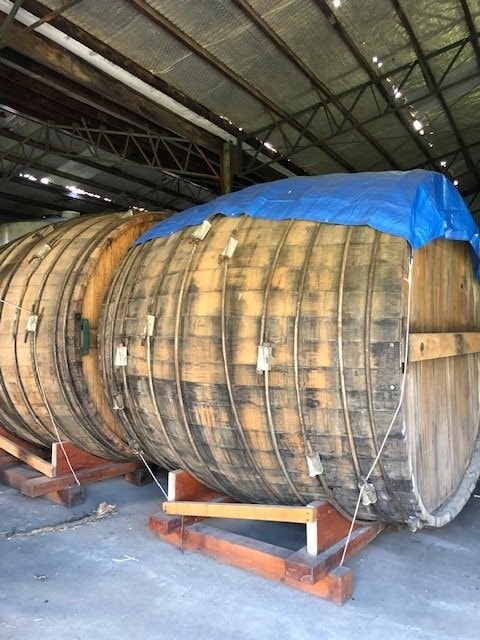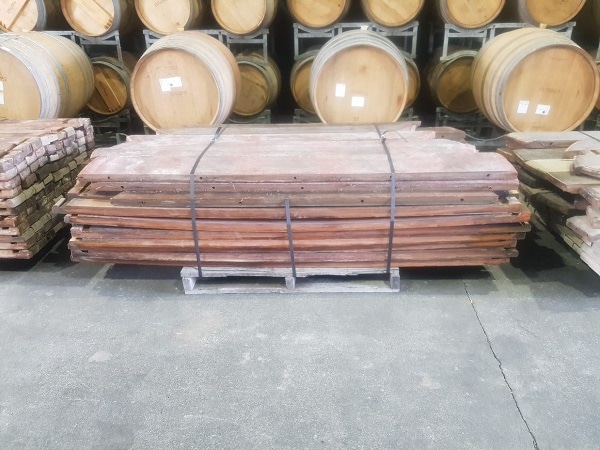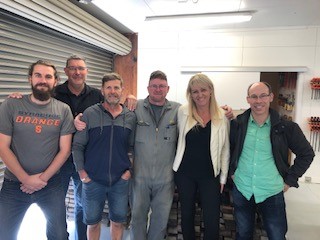Incorporating NZ wine history into the BRI research winery
Earlier this year, Villa Maria generously donated 3 tōtara cuves from their Esk Valley Winery in the Hawkes Bay to BRI. The use of tōtara in coopering is a unique – and little known – part of New Zealand wine history. Creating cuves out of tōtara was an example of the ‘Number 8 fencing wire’ approach adopted by the some of our early winemaking pioneers. See more on the history of tōtara cuves in NZ winemaking below…

Tōtara cuves at Esk Valley Winery
As part of the Sustainability Plan of the BRI Research Winery, the tōtara cuves will be upcycled into a table that will take pride-of-place in the new conference space. Recycling this timber is not only sustainable but preserves an important part of NZ wine history, and the table design will reflect this. More on this in the next blog…

Tōtara cuves staves, ready for transporting from the Hawkes Bay to Nelson
It is also a way to meet another BRI goal – partnering with education. BRI offered the NMIT Carpentry unit in Nelson the opportunity to design and build this unique table, an opportunity that will capture the essence of the barrels whilst providing functionality for meetings and events.

Tracy Benge (Establishment Manager – BRI) with Simon Hall (Architect – JTB Architects) and the NMIT Carpentry team in Nelson (front row from left to right) Luke Beaston, Andy Waugh, Huw Morgan and (back row) Eddie Shields.
BRI are delighted to be able to both preserve and showcase this history in their new Research Winery in Marlborough.
As part of this project we have been trying to learn more about the historical use of tōtara in New Zealand winemaking. Oak was not available for barrel making, tōtara was found to be a very good substitute as it was straight, knot free, hard, medium tight grained and neutral (imparted no flavor on the wine).
The majority of cuves made from tōtara ranged from 1,500 to 4,500 liters, but smaller volumes were also made. Most tōtara cuves were manufactured in Auckland, and neighboring regions, by coopers of Croatian descent.
‘The Croatian procedure for making the barrels was very much hand done, from shaping the staves with a plane, to boiling water in tin troughs over an open fire that they would put the staves in so they could in turn bend them. This procedure was adopted by the Croatian gentleman Mr Bakarich, who made some for my Grandfather in the 1930s’, said Tony Soljan, of Soljan Estate. He went on to say, ‘A Mr Woolf had a Cooperage in Newmarket, Auckland and made barrels for breweries, he also made tōtara barrels for wineries and the ones that we still use, were made by him’. While Anthony Ivicevich, of Westbrook Wines, said, ‘…the cooper that made the ones for the then Panorama vineyard was a Mr. Corran, who I think lived in Pt Chevalier, Auckland in the late 1930’s early 1950’s. He made some 20 x 500-gallon barrels for our winery back then…’.
Mr. Ivicevich added, ‘…some of the tōtara cuves were made wider at the bottom than the top, some with open tops so freshly harvested grapes would be fermented in them easily, enabling the cap to be plunged daily’. Tōtara was not used to impart flavour onto a wine, but several sources have indicated that the wood absorbed favorable characteristics from wines stored in them and subsequent wines stored in the barrels absorbed these flavours.
These relics of New Zealand winemaking can still be found in wineries around the country today.
















